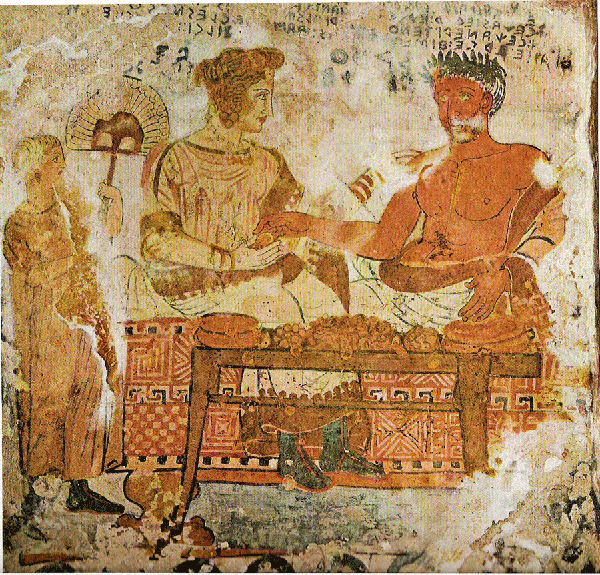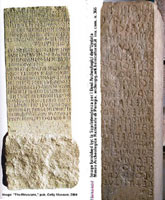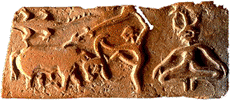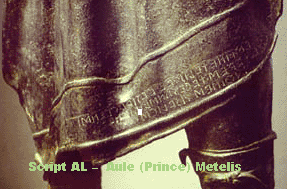Documentary: Getting to know the mysterious Etruscans
A treatment
By Mel Copeland
Author's note: The main interest of this documentary is to start a conversation on the Etruscan origins, and any affect on Indo-European movements in the late Bronze Age, etc. So far — because of the prevailing stiff-arm exercised by the Pallotino et al. theory — "that Etruscan is not Indo-European, and is an isolate" — no conversation has been allowed. While the Pallotino school claims to translate select words of the Etruscan texts there continues to be confusion over the meaning of the texts, leaving any knowledge to be gained from the texts to the distant future. Thus, any attempt to understand the Etruscans from the Etruscan's own point of view has been thwarted. The "Etruscan as a language isolate" theory propagated by Pallottino and Staccioli in the 1940s continues to cast doubt on any other effort to translate the Etruscan texts. Archeologist Larissa Bonfante ("Etruscan Language,") continues to lead this school of thought. Contesting the school with his work on the Etruscan language is scholar Mel Copeland who uses Etruscan pictures on murals and mirrors to illustrate the Etruscan translations and grammar he has developed.

The film begins with a seated narrator holding the Iliad of Homer with an Etruscan mural, the Banquet scene from the Tomb of the Shields, behind him/her. The narrator explains the story about to be told with the irony being that though we can see clearly what is taking place in the Tomb of the Shields our view is incomplete. For there is writing on the mural and prominent Etruscan scholars say that the writing is unlike any other and eludes being deciphered. The narrator opines:
”Etruscan is one of the greatest mysteries of the ages, for the Etruscan language ceased to be spoken in Italy since about 400 B.C. But in the time of Julius Caesar and the philosopher Cicero, ca 43 B.C., there were some Etruscan priests who were still able to read the mysterious Etruscan alphabet. Cicero himself took pride in his Etruscan heritage, for then — and even now — Etruria (now known as Tuscany) was known as a higher culture than that of Rome, and those of Etruscan heritage were considered the “blue-bloods” of their time. On the other hand, Julius Caesar took pride in his pure Roman heritage — as described in Virgil’s Aeneid — that derived from a prince Aeneas of Trojan fame. (Image: http://www.maravot.com/Etruscan_mural_banquet7.gif)
”Both Caesar and Cicero owed much to Etruscan civilization. The alphabet they used — as we do today — was Etruscan and Etruscan gold work and metal refining, of iron and copper, was second to none.
”When Rome was yet a small settlement an Etruscan noble and his wife from Tarquenia moved to Rome and began a dynasty of kings called the Tarquins. In subsequent years Rome and Etruria became archenemies, constantly at war. But the Etruscans controlled the seas. They were great seafarers, trading far and wide, from the interior of France to the Black Sea coasts. In the Greek myth of the god Dionysus — a god of drink and merriment — the god as a youth was kidnapped by Tyrrhenian pirates. The Greeks called the Etruscans Tyrrhenians or Tyrsenians. The sea off the coast of modern Tuscany still bears the Tyrrhenian name. Like the Mycenaeans before them the Etruscans controlled the seas. But then the Greeks got into the act, sending colonies to settle in Spain, southern France (Marseille, then known as Massila) and Italy. The Aeneid mentions a Greek colony within the territory of the Etruscans, and pushing upon the Etruscan Campania from the south, in Sicily and Naples, were Greek colonies. One of the earlier myths involving Greek colonization involved that of the architect of the Labyrinth that held the Minotaur of King Minos of Crete. He is said to have been tracked down by Minos’ henchmen where he was hiding in Sicily.
”We find that when we begin telling Etruscan history it involves Greek mythology as well. In fact, the Greek myths were composed to explain the origins of the Greeks and mankind, as stemming from the gods. We may wonder how the Etruscans viewed these stories. It turns out that the Etruscans left records, some of which, like the mural behind me, contained pictures to accompany the text. Some of the stories are finely engraved on mirrors.”
The documentary features tours and images showing a common megalithic, tumuli culture from the Scythian tombs of the Crimea and Ukraine, around Mediterranean shores Troy, Lydia, Phrygia, Greece, Romania, Bulgaria, the Adriatic coast, Italy, Portugal, Spain, Brittany, Britain and Germany. The tumuli become a key to the timeline of our story. The narrator resumes:
"In Homer's Iliad Achilles’ best friend, Patroclos is killed and the Greek warriors raise a tumulus to mark his grave. The burial involved about a week’s worth of war games, the sacrifice of prisoners, and the sacrifice of horses and treasure upon the burning bier of the dead hero. This description of the burial of Patroclos sets an image of what might have taken place involving other like burials.
”Understanding the ancient views and practices can even correct the historical record. The Roman historian Pausanias (160 CE) claimed that Agamemnon's tumulus is outside the walls of Mycenae. This also says that the gold masks found in Mycenae's grave circle during the last century probably did not include Agamemnon's.”
We now turn from the seated story-telling segment to the narrator’s walk down from Mycenae into the Treasury of Atreus that then bleeds into a tour of an Etruscan tomb, followed by a walk through some museums. The narrator would discuss the Mycenaean connections to the Etruscans, how the 10-year-long Trojan War perhaps led to a drought, causing Trojans and their allies to flee the land. He would compare the flight of those Sea Peoples to modern sea-people migrations, such as the Vietnamese during the Vietnam War and today's Afghanis and Pakistanis from the Afghanistan War.
The narrator continues: "Troy ceased to exist ~1180 B.C., the Hittite capital was destroyed in 1189 B.C.; Egypt recorded Sea Peoples' invasions about that time. Suddenly the great cities of the Mycenaean civilization were destroyed: Nestor's Sandy Pylos, Mycenae, Tyrns, etc. Twentieth Century archeologists found in their ruins large inventories of tablets, and those written in Linear B, deciphered by Michael Ventris, described those invasions."
The cultural connections of the Etruscans to the Indo-European tumuli builders would be the focus of the documentary, leading to a linguistic confirmation: that the Etruscan language is in fact closely related to Latin, Italian & French. Since Etruscan ceased to be spoken, frozen in time about 400 B.C., it is a window into the early Indo-European languages. We may wonder how they viewed history, from the dawn of their civilization about 1,000 B.C. to its decline. The narrator points out a small bronze bust in the Louvre of a beautiful young woman who has written on her forehead, Queen Sarina (one of several small busts regarded as "votive" figures). The narrator then is standing in the museum of Perugia, next to the stele, Perugia Cippus, pointing to that name on the stele. "It is one of many names of kings and queens listed on the stele," according to Copeland, he says. The narrator points out that this is the first look at an Etruscan historical record and an image of one of the names in the record.
Perugia Cippus, pointing to that name on the stele. "It is one of many names of kings and queens listed on the stele," according to Copeland, he says. The narrator points out that this is the first look at an Etruscan historical record and an image of one of the names in the record.
The narrator picks up a small golden brooch and reads the inscription upon it. It has the finest gold work and reads, "My gold "chiave" (key) you praise Nasia the great." The narrator then picks up another artifact, a mirror MS565/2 from the Schøyen Collection, that tells the story of Icarus, the first disciple of Dionysus. The narrator points to an image of children swinging in a tree.
"The children have continued that practice," the narrator says, ever since Icarus was murdered by some shepherds that got drunk from the wine he introduced to them. His faithful dog, Maera, seeing the assault dove into a nearby well in his grief and his daughter, seeing her deceased father, hung herself on a nearby tree. Every year thereafter children took to swinging in the trees in memory of her death."
page 2
The narrator holds other mirrors. They all contain writing, and one of them portrays the entire story of the Trojan War. The narrator mentions that these mirrors have been found from far into the interior of France all of the way into the Black Sea. Curiously the mirrors identified the heroes and gods pictured on them in Etruscan script. Was Etruscan a commonly known language back then?
The narrator picks up a Greek vase and points out that Etruscan potters in fact made some of the finest examples of Greek pottery. And in turn Gauls in Southern France began copying Etruscan forms — particularly their wine decanters. "Were the Etruscans the post Trojan War era traders carrying on the Mycenaean tradition?" the narrator asks.
The narrator stands in front of an Etruscan mural from a tomb. A young couple is seated on a bench enjoying a banquet. It is a banquet for the dead. The narrator compares the scene to a Thracian tomb (The Kazanluk tomb).
"It's a Banquet with the gods, familiar to many tombs in Lydia and later, including Persian tombs. Most importantly, the images present a ritual often repeated in the Rig Veda of the early Indo-European invaders to India. They would sit no doubt cross-legged before the sunrise and invite the gods, one by one, to join them in their feast. The feast included Soma, a drink manufactured from Cannabis. Often horses tied to a nearby post were sacrificed in the feast. We can reflect on this image through the courtesy of an Indus Valley "Harrapa" seal that contains a man seated cross-legged wearing an antler headdress attending a sacrifice. This character is very much similar to the Celtic god Cernnunos seen on the Gundestrop Cauldron, discovered in Germany."
images present a ritual often repeated in the Rig Veda of the early Indo-European invaders to India. They would sit no doubt cross-legged before the sunrise and invite the gods, one by one, to join them in their feast. The feast included Soma, a drink manufactured from Cannabis. Often horses tied to a nearby post were sacrificed in the feast. We can reflect on this image through the courtesy of an Indus Valley "Harrapa" seal that contains a man seated cross-legged wearing an antler headdress attending a sacrifice. This character is very much similar to the Celtic god Cernnunos seen on the Gundestrop Cauldron, discovered in Germany."
The narrator takes the viewer to the tomb of Midas, in the Phrygian capital. "This tomb," the narrator says, "is very much like that of a famous German chief. The timbered construction is nearly identical and the offerings with chariots, wagons, and horses are similar. Both inhumation and cremation are evidenced in the tomb, not unlike those of British tumuli."
The narrator returns to an Etruscan tumulus and points out both inhumation and cremation urns.
"The practice of cremation and burial of the urns in family tombs, as well as urn fields, can be seen here and in Britain but also down the Danube, all the way back to the tumuli and urnfields of Troy."
Behind the narrator is a mural of the Greek hero Achilles upon his horse at the well of Troy.
"Like the Trojans the Etruscans were known to be great horsemen, but greatest among them were the Thracians whose king sent his four white chargers to support the Trojans in their war."
"Were the Etruscans fascinated with Greek stories, recording them in their tombs and upon precious mirrors and pottery?" the narrator asks, "or were the Etruscans part of the story?"
The narrator picks up the "Divine Mirror" again, now seated with the Iliad beside his chair.
"This story of Helen of Troy, the cause of the Trojan War, is not exactly the same as recorded in the Greek myths." For it shows a Lydian goddess called "Mean" crowning Paris (Alexander) the prince of Troy, while Helen is striking a bargain with the Mycenaean king Agamemnon for the hand in marriage to his brother Menelaos. Helen is featured in other mirrors, with her name being spelled: ELINAI — as in this divine mirror — and ELINEI, following the declensions of other goddesses, including MUSEI and PERSIPNEI (goddess of Hades, Persephone) seen in a mural in the Tomb of Orcos. Also unlike the Greek myth Heracles (Etruscan HERCLE) is part of the story, standing beside Aphrodite (Etruscan Turan). Heracles essentially had nothing to do with the Helen of Troy saga. What is he doing in this story?
"Mean appears to have the same qualities as the perpetual virgin goddess Artemis, a huntress. In Greek myth it is Aphrodite (Etruscan Turan) who created the arrangement with Paris to take the hand of Helen. She rewarded Paris with the hand of the most beautiful woman in the world because he judged that she was fairer than the other goddesses Hera and Athena. (Image: http://www.maravot.com/Divine_Mirror.html)
page 3
"Nevertheless Artemis is associated with the story: She was peeved at Agamemnon's family, for his father, Atreus, had held back a sheep from sacrifice that he had dedicated to Artemis (Etruscan ARTUMES, ARTVMEI (a mirror showing HERCLE MALAFIS [Heracles the "mischievous"), ARTVMEI and APLV [Apollo]), ARTVMIS). The sheep had golden fleece and is that very same sheep that Phrixus rode, flying through the air, to Colchis. Jason and the Argonauts later sought to steal that sheep. Note that the two spellings of Artemis are different declensions."
The narrator picks up another mirror.
"There are a host of Etruscan mirrors that carry the entire saga of the Trojan War and developments afterwards. Here is the 'Judgment of Paris' and here is another of Agamemnon's son, Orestes (Etruscan VRVSTHE, also spelled in other mirrors as VRSTE the Etruscan "V" = "o"). It shows Orestes murdering his mother, Clytemnestra. She had carried on with another man while her husband was leading the war in Troy. When Agamemnon returned from the war, Clytemnestra and her lover conspired to murder him in his bath. When Orestes heard about the murder he returned home to Mycenae to avenge his father's murder. There was a moral problem in murdering his mother, so he consulted Apollo at Delphi. The oracle told him to avenge the death of his father. This interesting mirror shows both Jason (Etruscan AEITHEVN) and Orestes together. It is interesting because both murdered their parent, with Apollo's consent. In the lower scene of this mirror Jason is slaying the dragon that defended the Golden Fleece."
The narrator picks up Herodotus’s Persian Wars.
“It says here that the Etruscans were originally from Lydia, led to Italy by the son of King Attys. (Attys is a name given to many generations of Lydian kings.) There was a drought after the war — no doubt as a result of the Greeks and the Trojan allies raiding the Lydian countryside during the ten years at war.”
The narrator continues — pointing to an image of an Etruscan Orator.
"On the back of his robe is writing that identifies him as Aule Metellis of the Clensi clan.  (Aule is a common Latin name, also meaning lord, prince.) It concludes, '[The people of] Turin whom he changed' (i.e., TVRINES KIS FLICS — L. Augusta Taurinorum; whom L. quis; I change (L. verb flexo, 1st pers. sing. Etruscan flex).
(Aule is a common Latin name, also meaning lord, prince.) It concludes, '[The people of] Turin whom he changed' (i.e., TVRINES KIS FLICS — L. Augusta Taurinorum; whom L. quis; I change (L. verb flexo, 1st pers. sing. Etruscan flex).
The narrator picks up another Etruscan mirror.
"If we take the time to go through the many Etruscan mirrors and murals that contain writing we will find a common grammatical pattern in the spelling of recognizable mythological names and the phrases in which they are used. These patterns shed light on grammatical forms in the longer Etruscan texts, the longest of which is on a mummy wrapping called the 'Liber Linteus Zagrabiensis,' (i.e., the Zagreb book of linen) now in the Zagreb Archeological Museum. The text itself has been the subject of much controversy, with many different claims of translating it."
The narrator continues...
Mel Copeland
Berkeley, CA
7.29.10
http://www.maravot.com/Etruscan_Phrases_a.html
Launched 7.28.10
Updated 7.31.10
page 4
— | ♦
Updated:
Copyright © 1981-2010 Maravot. All rights reserved
Copyright© 1981-2010 Mel Copeland. All rights reserved